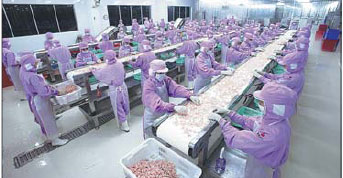Belt and Road enhances region's seafood industry
The Belt and Road Initiative has provided huge opportunities for expanding Sino-foreign cooperation in ocean and aquatic product industries, said an industrial association official.
Tian Quanhai, chairman of the China Aquatic Production Chamber of Commerce under the All-China Federation of Industry and Commerce, urged aquatic industry players to grasp opportunities to further advance cooperation with their foreign counterparts along the trade routes in the years ahead.
The initiative, proposed by the Chinese government in 2013, envisages a Silk Road Economic Belt and a 21st Century Maritime Silk Road, covering about 4.4 billion people in more than 60 nations and regions in Asia, Africa and Europe.
"The annual China International Aquatic Products Expo in Zhanjiang is a good platform to offer trade and business opportunities between domestic and foreign companies," Tian said.
The 2016 expo, the second-largest of its kind on the mainland, will take place in Zhanjiang from June 18 to 20. It is jointly organized by the China Aquatic Production Chamber of Commerce under the All-China Federation of Industry and Commerce and Zhanjiang Aquatic Products Import and Export Association.
"International cooperation in the aquatic industry has great potential in the years ahead and will certainly boost the Chinese industry, which is already playing an increasingly important role in China's economy," Tian said.
He said he hoped to see more Chinese companies expand their presence in the global market via Sino-foreign partnerships in the coming years.
Tian promised his chamber would try to build more platforms and channels for domestic companies to go global in the future.
China is not only the biggest country in aquaculture, but also the largest in aquatic product trade and consumption.
"But the domestic industry is facing its toughest time in two decades mainly because of the sluggish global market," Tian said.
According to statistics from the Chinese customs department, China's foreign trade of aquatic products was 8.14 million metric tons, valued at $29.31 billion, in 2015, a reduction of 3.59 percent and 5.08 percent from a year earlier.
Orders from Japan, the United States, Europe and South Korea in 2015 witnessed a big reduction, although contracts from Southeast Asian nations increased.
Thailand was China's biggest trade partner in aquatic products last year.
China sold $1.2 billion worth of aquatic products to Thailand in 2015, accounting for 43.23 percent of the total to Association of Southest Asian Nations members. China mainly sold tuna, cuttlefish, squid and octopus to the region.
The coastal provinces of Guangdong, Fujian, Shandong, Hebei, Liaoning Zhejiang and Hainan were the major aquatic products sellers abroad. Their exports account for 93.67 percent of the country's total.
China's fishery industry generated a total output worth 173.1 billion yuan ($26.4 billion) in the first three months of 2016.
zhengcaixiong@chinadaily.com.cn
|
Visitors select seefood during an industry show in Zhanjiang. |
|
Employees process seafood to meet market demand. |
|
The Haifeng Aquatic Products Co in Zhanjiang displays products at last year's aquatic products expo. |
(China Daily 05/30/2016 page6)











